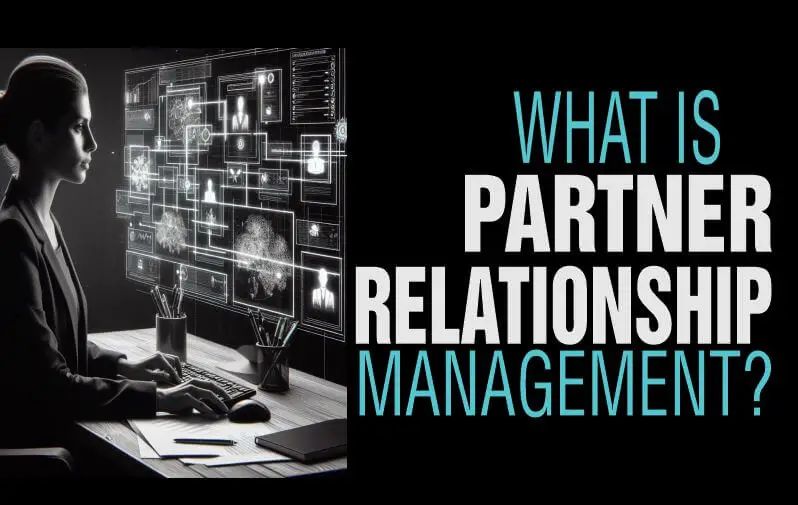Last updated on July 14th, 2024 at 05:48 pm
Many organizations understand the value of partner relations management and invest significant resources in developing and managing them.
This is where partner relationship management (PRM) comes into play.
PRM covers a wide range of strategies and practices aimed at cultivating and nurturing business alliances to maximize mutual benefits.
We have detailed everything you need to know as we discuss its importance, key elements, and effective strategies for managing relationships with partners.
Related: Understanding Relationship Management
Table of Contents
- What is Partner Relations Management / Partner Relationship Management?
- Who is a Partner Relations Manager?
- Types of Partner Relations Manager
- Partner Relations Manager Skills
- Importance of Partner Relations Management
- Key Elements of Partner Relations Management
- Strategies for Successful Partner Relations Management
- Leveraging Technology for Efficient PRM
- Challenges of Partner Relations Management
- Strategies for Overcoming Partner Relationship Management Challenges
- Frequently Asked Questions
- Final Thoughts
What is Partner Relations Management / Partner Relationship Management?
Partner relations management is a systematic approach to developing and maintaining strong relationships with business partners.
It involves a set of strategies, tools, and processes to ensure effective collaboration, communication, and mutual growth between two or more organizations.
PRM includes activities such as partner selection, onboarding, relationship cultivation, joint planning, performance tracking, and conflict resolution.
When the focus is on building trust, encouraging clear communication, and aligning objectives, PRM helps organizations create long-term, mutually beneficial partnerships.
Partner relationship management is the strategies, processes, and technologies that organizations use to manage and enhance their relationships with their channel partners.
It is a comprehensive approach that focuses on building mutually beneficial partnerships to maximize sales, strengthen customer relationships, and increase overall business growth.
Related: Understanding the Community Relationship Manager
Who is a Partner Relations Manager?

A partner relations manager is a mix of technology (software) and other processes responsible for nurturing and maintaining relationships with external partners, such as resellers, distributors, and alliances.
Their role involves facilitating effective communication, understanding partner needs, aligning goals, and ensuring mutual success.
They develop and implement strategies to strengthen partnerships, resolve conflicts, and maximize the value of collaborative efforts.
This role requires strong interpersonal skills, strategic thinking, and the ability to balance the interests of both the company and its partners.
Types of Partner Relations Manager
There are several types of designated partner relations as we will detail below:
1. Strategic Partner Relations Manager
This type of manager is responsible for developing and maintaining relationships with strategic partners, such as key customers, suppliers, and industry influencers.
They coordinate partnership activities, identify new business opportunities, and ensure that both parties benefit from the partnership.
2. Channel Partner Relations Manager
This type of manager focuses on managing relationships with channel partners, such as distributors, resellers, and agents.
They work closely with these partners to ensure they have the necessary resources, training, and support to effectively sell and promote the company’s products and services.
3. Alliances Partner Relations Manager:
his type of manager is responsible for managing relationships with strategic alliances, such as joint ventures, collaborations, and partnerships with other companies.
They work to build mutually beneficial partnerships, coordinate alliance activities, and ensure that both parties achieve their objectives.
4. Affiliate Partner Relations Manager
This type of manager is responsible for managing relationships with affiliate partners, such as bloggers, influencers, and website owners.
They work to recruit and onboard new affiliates, provide them with the necessary resources and support and track and optimize their performance to drive successful affiliate marketing programs.
Related: What is Client Relationship Management?
5. Customer Partner Relations Manager
This type of manager focuses on managing relationships with key customers.
They work closely with these customers to ensure their needs and expectations are met, gather feedback and insights, and identify opportunities for upselling, cross-selling, and retention.
6. Investor Partner Relations Manager
This type of manager is responsible for managing relationships with investors and stakeholders.
They work to build and maintain strong investor relations, communicate the company’s financial performance and strategic initiatives, and address any concerns or inquiries from investors.
7. Employee Partner Relations Manager
This type of manager focuses on managing relationships with employees and internal stakeholders.
They work to build and maintain a positive and productive work environment, address employee concerns and grievances, and ensure effective communication and collaboration within the organization.
Related: Skills Required for a Business Relationship Manager
Partner Relations Manager Skills

A partner relations manager needs a diverse skill set to effectively manage and nurture relationships with external partners.
Key skills include:
- Communication: Excellent verbal and written communication skills to convey information clearly and build rapport with partners.
- Negotiation: Ability to negotiate mutually beneficial agreements and resolve conflicts diplomatically.
- Strategic Thinking: Capacity to develop long-term partnership strategies aligned with business goals.
- Relationship Building: Strong interpersonal skills to foster trust and collaboration with partners.
- Problem-solving: Aptitude for identifying and addressing challenges within partnerships.
- Business Acumen: Understanding of the industry, market trends, and the partner’s business to drive successful collaborations.
- Adaptability: Flexibility to navigate diverse partner needs and industry dynamics.
- Analytical Skills: Capability to assess partnership performance and make data-driven decisions.
- Leadership: Ability to influence and align internal and external stakeholders towards common objectives.
- Customer Focus: Dedication to understanding partner needs and delivering value to enhance partner satisfaction and loyalty.
Related: Defining a Relationship Manager
Importance of Partner Relations Management
Of course, just like other relationship management, many benefits accrue from partner relationships as we will detail below:
1. Enhanced Competitive Advantage
Partnering with the right organizations can provide access to complementary resources, knowledge, and expertise that can strengthen the competitiveness of both parties involved.
PRM enables businesses to leverage these partnerships to deliver unique value propositions and gain a competitive advantage in the market.
2. Expanded Market Reach
By collaborating with partners, organizations can penetrate new markets, reach untapped customer segments, and extend their geographic coverage.
PRM supports businesses in identifying potential partners and establishing mutually beneficial relationships to increase market presence and sales.
3. Increased Innovation
Partnering with external entities opens the doors to new ideas, perspectives, and innovations.
Through effective PRM, organizations foster knowledge exchange, co-creation, and collaboration, leading to greater innovation and the development of unique products or services.
4. Lower Costs and Risks
Partnering allows businesses to share costs, risks, and resources, enabling them to achieve economies of scale or scope that may otherwise be unattainable.
PRM assists in structuring and managing these alliances, ensuring both parties benefit from reduced costs and minimized risks.
Related: Introduction to Business Relationship Management
Key Elements of Partner Relations Management

1. Selection and Alignment: Careful selection of partners based on compatibility, shared vision, and complementary capabilities is essential.
2. Relationship Building: Effective relationships with partners rely on establishing strong relationships based on trust, transparency, and open communication.
3. Joint Planning: Collaborative planning enables partners to align their strategies, objectives, and resources to achieve common goals.
4. Effective Communication and Collaboration: Clear, open, and timely communication is vital for successful PRM.
5. Performance Tracking and Evaluation: PRM involves measuring and evaluating partnership performance against predefined metrics.
Strategies for Successful Partner Relations Management
1. Establish a Dedicated PRM Team: Create a specialized team responsible for managing relationships with partners, ensuring they have the necessary skills in communication, negotiation, and conflict resolution to foster successful partnerships.
2. Build Trust and Commitment: Encourage trust through transparent and ethical behaviour, aligning interests, and maintaining consistent communication.
3. Develop Mutual Benefit: Identify opportunities for collaboration, co-marketing, and co-development to create win-win outcomes for both parties.
4. Regular Communication and Feedback: Maintain regular and open communication channels, providing partners with timely updates, sharing market insights, or seeking their feedback on joint initiatives.
5. Continuous Improvement and Adaptation: Regularly evaluate the partnership’s performance, identify areas for improvement, and adapt strategies to align with changing market conditions.
Also Read: Relationship Management in Banking
Leveraging Technology for Efficient PRM
Leveraging technology for the efficient management of partner relationships involves the use of various digital tools and systems to streamline and enhance the way businesses manage their relationships with partners.
1. Customer Relationship Management System
One way businesses can leverage technology is by implementing a customer relationship management (CRM) system.
This software allows businesses to store and track important partner data, including contact information, communication history, and any ongoing projects or deals.
With a CRM system, businesses can easily access and update partner information, enabling more efficient and effective communication and collaboration.
2. Collaborative Management Software
Another technology that can be leveraged is collaborative project management software.
This allows businesses and their partners to work together on shared projects, track progress, assign tasks, and share important documents and resources.
With such software, businesses can ensure that all parties are aligned and working towards common goals, leading to increased efficiency and productivity.
3. Video Conferencing Software
Additionally, businesses can leverage technology to improve communication with their partners.
This can involve the use of tools such as video conferencing software, instant messaging apps, and project collaboration platforms.
By using these digital communication tools, businesses can enhance real-time collaboration, reduce the need for in-person meetings, and facilitate communication across different time zones and locations.
Furthermore, leveraging technology can also involve the use of data analytics tools to gain insights into partner performance and identify areas for improvement.
By analyzing partner data and metrics, businesses can make informed decisions, optimize their relationships with their partner, and identify new growth opportunities.
Related: Relationship Management in Emotional Intelligence
Challenges of Partner Relations Management
- Communication Breakdown: Miscommunication or lack of effective communication between the company and its partners can lead to misunderstandings and hinder the success of PRM.
- Misaligned Goals: When the goals and objectives of the company and its partners are not aligned, it can create conflicts and impede the partnership’s effectiveness.
- Resource Constraints: Limited resources, such as time, budget, or personnel, can pose challenges in implementing and maintaining effective PRM strategies.
- Competitive Pressures: Partners may face competitive pressures that affect their ability to fully commit to the partnership, impacting the success of PRM initiatives.
Strategies for Overcoming Partner Relationship Management Challenges
- Clear communication channels: Establishing clear and open lines of communication, utilizing technology and regular meetings, can help mitigate communication breakdowns.
- Goal Alignment: Collaboratively setting clear, mutually beneficial goals and regularly reviewing them can ensure that both parties are working towards common objectives.
- Resource Optimization: Finding ways to optimize resources, such as through the use of PRM software or streamlining processes, can help overcome resource constraints.
- Collaboration over Competition: Encouraging a collaborative environment and providing support to partners can help alleviate competitive pressures and strengthen the partnership.
Frequently Asked Questions
What do you mean by partner relationship management?
PRM involves strategies and processes to manage relationships with various partners for mutual benefit and success in business collaborations.
What is the meaning of partner relations?
It is the overall interactions and connections between a company and its partners, encompassing various aspects of the partnership.
How do you manage a partner relationship?
Managing relationships with partners involves clear communication, collaborative goal-setting, transparency, and mutual support to ensure a successful and beneficial partnership.
What does partner relationship management focus on working with?
PRM focuses on working with various types of partners, such as resellers, distributors, and alliances, to achieve common goals and mutual success.
Final Thoughts
Effective partner relations management is essential for businesses aiming to establish and maintain successful partnerships.
By focusing on trust, collaboration, and alignment of objectives, organizations can achieve enhanced competitiveness, expanded market reach, increased innovation, and lower costs.
Investing in a partner relations manager enables businesses to build strong, long-lasting alliances that drive mutual growth and deliver sustainable value in an ever-evolving business landscape.
References:
- https://www.workspan.com/guide-to-partner-relationship-management-prm
- https://affise.com/blog/partner-relationship-management/
- https://www.salesforce.com/blog/what-is-partner-relationship-management/
- https://www.zinfi.com/blog/partner-relationship-management-explainer/
Pyo Merez (PsyD) is a distinguished adolescent and adult psychologist at the forefront of mental health advocacy.
With expertise in cognitive and developmental psychology, focusing on social relationships, cultural contexts, and individual differences, Pyo has dedicated his career to empowering adolescents and adults.
As a sought-after speaker and panelist, Pyo shares invaluable insights on issues affecting young people, contributing to a deeper understanding of mental health and well-being in today's society.


